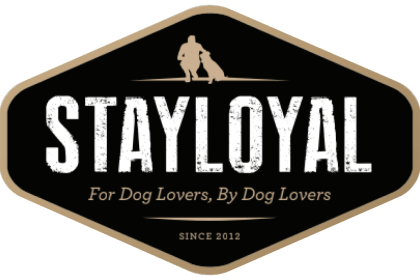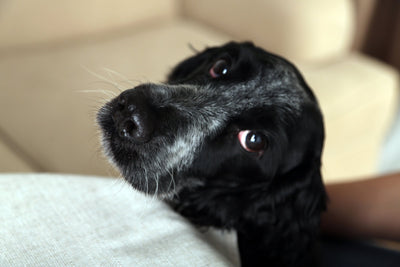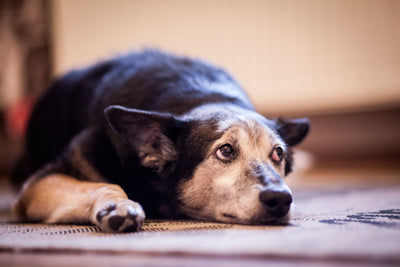Tips to Teaching Paw Tricks

Paw tricks are not only adorable, they can also be a great way to get your dog used to his paws being handled or give him something appropriate to offer when greeting people (i.e. offering a paw to shake rather than jumping on someone). Common paw tricks include shake (like shaking your hand), wave, and high five or high ten. Although paw tricks may seem simple, there are techniques that can make training them a whole lot easier.
One of the biggest tricks is the order in which you train these. The following order makes them easier for your dog to learn without getting mixed up.
Shake Tips
Shake is useful for helping your dog get used to having someone hold their paw, for example the groomer for a nail trim, or the vet for an exam.
You want to shape the behaviour so that your dog willing gives you his paw. To do this, put a treat in your hand, make a fist, and place it on the ground, palm side up, near your dog’s mirrored foot (so your right hand his left paw). MOST dogs will paw at your hand to get the treat. Praise your dog and reward him with food, petting or play (whatever your dog likes most!)
Repeat a few times until your dog is immediately placing his paw on your hand. At this point, remove the treat and see if your dog will still target your closed fist. If the first step was done properly, he will! Then, you can start to open your hand, until your dog is placing his paw in your open hand.
Your dog is probably just quickly placing his paw on your hand and then removing it. In order to get duration, you need to delay your mark and reward. This should cause your dog to leave his paw on your hand longer, as he waits for the praise. The first time, he may remove his paw and immediately put it back on your hand. That’s okay. Wait until you are getting a second or two of contact.
Gradually build up the duration until he is leaving his paw in your hand for a few seconds. At this point, gently close your hand around his paw. Praise and reward for that.
Once your dog is fine with you closing your hand around his paw, you can add the up and down movement of a handshake if you wish, but you don’t have to.
If you want to add a verbal cue (the visual cue is just you reaching out with your hand), add the cue by saying the word Shake as you close your hand around your dog’s paw. After a few repetitions, test the cue by saying shake and seeing if your dog offers his paw to you. If not, go back to saying the cue while doing the behaviour.
Most dogs will offer the same paw every time, so now it’s time to see if you can get your dog to do it with his other paw! This is really up to you, but if you want, you can teach your dog to shake with both paws. Just repeat the above with the same steps, but use your other hand. Using the mirrored hand helps your dog figure out which paw you want. You can use the same cue for each paw, or have two different cues, such as Left and Right, or Shake and Other Paw.
Wave Tips
For the wave, you will follow similar steps as above, except hold your hand with the treat up higher, so your dog has to raise his paw to get at it. Also, this time mark/reward your dog as he is reaching up with his paw to touch your hand, but has not touched it yet.
Some dogs may try to nose it at this point. If this happens, move your hand lower, until he starts using his paw instead of his nose. You may have some trial and error at first. If he uses his nose, be sure to not mark/reward. This is why it’s recommended to do this trick second, so your dog already has a reinforcement history of getting rewarding for using his paw on your hand.
In this case, you want to remove your hand from the picture. Once your dog is repeatedly putting his paw in the air, but has stopped trying to touch your hand (you will see him stop “following through” with his paw), you can try removing your fist from the picture.
Two ways to do this:
Remove your hand completely – some dogs will “have it” and will keep pawing the air even if you just remove your hand.
Fade your fist – others, you will have to fade your fist by slowing moving it further and further away from your dog while he is still performing the wave.
Once your dog will offer to wave his paw without your hand in view, it’s time to add the cue.
Add the cue by saying the word Wave as your dog offers to wave his paw. After a few repetitions, test the cue by saying Wave before your dog lifts his paw and see if your dog offers his paw to you.
High Five or Ten Tips
At this point, if you give your dog your hand, he is probably going to try and put a paw on it, considering the amount of reinforcement he has received for doing so. This is why it’s best to do high five last, because you need an open hand.
Following the same basic guidelines as above, you are going to produce your open hand this time, just like you would if you were giving a person a high five. Praise/mark your dog for touching it, which he should do quite readily after the last two tricks.
Like with Wave, you may have to experiment with height – what height of your hand makes it easiest for your dog to place his paw on it?
High five can have a verbal cue, or it can just be the visual of you offering your hand. If you want to add the cue, just say the words as he places his paw on your hand.
Like with Shake, you can now repeat this process with your other hand and your dog’s other paw.
High ten can be achieved by producing both your hands to your dog at once, after they have learned both separately
Dog not offering his Paw?
If your dog has issues with you touching his paws or just does not seem interested, there are a few things you can do.
Use a toy for your dog to target with is paw instead of your hand at first, just to get him into the game.
For wave, you can put a Post-It Note or something else slightly sticky (nothing that will pull hair or skin!) on the bottom of the paw and then praise/reward for the raising/shaking your dog does trying to get it off.
If you need your dog to reach up higher for wave and high-five, sit on the floor with your knee slightly bent, your dog on one side and a treat or toy on the other. Most dogs will paw at the leg to get what they want, this can also work for teaching wave if your dog won’t target your hand.
At the end of the day, paw tricks are fun and really are just about developing a relationship with your dog. There may be some trial and error as you figure out what works best for your dog, but that just strengthens your bond. So have fun and learn some tricks








